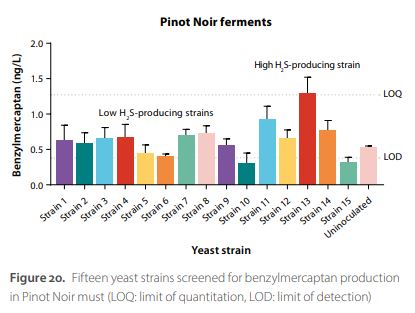Formation and fate of sulfur compounds associated with negative attributes in wine
Project summary
The occurrence of volatile sulfur compounds (VSCs) is influenced by factors including yeast selection and fermentation conditions; the nature and quantity of precursor compounds; the availability or absence of oxygen at different points of the winemaking process; and the availability and speciation of transition metal ions such as copper. As defence against the formation of undesirable VSCs, especially hydrogen sulfide, winemakers typically rely on monitoring must-nitrogen, additions of diammonium phosphate and copper, and choice of closure and its oxygen transfer rate. However, despite these commonly used management practices, post-bottling VSC release and sulfur-related off-flavours, can still be observed in some wines.
In previous AWRI research, a number of obvious sulfur-containing precursors (thioacetates, s-methyl methionine, cysteine, DMSO, glutathione, methionine, DMDS and methionol) have been assessed for their role in releasing VSCs, and results indicate that many of these do not play a significant role in post-bottling VSC release. This suggests that other precursors are present which are yet to be identified. Sufficient observational experiments have been established across a range of wines, to show that the accumulation patterns of VSCs are relatively consistent post-bottling, but that they differ significantly between red wine and white wine. It remains to be established whether the accumulation patterns observed are driven only by release from precursors or, more likely, a combination of release and subsequent loss of VSCs by incorporation into other chemical forms (e.g. binding into quinones, or the formation of compounds such as disulfides or polysulfanes). In addition to the de-novo formation of VSCs, their accumulation might also reflect their stability and reactions causing their ‘loss’ in wine. Thus there remains a knowledge gap relating to novel precursors and their degradation mechanisms, which will be addressed by this project.
This project will also characterise the role of yeast in forming precursors for VSCs, and the biochemical pathways that affect VSC formation. The yeast biochemical pathways associated with release of hydrogen sulfide from cysteine have been established. However, recent work indicates that sulfate, for example, is a key sulfur source incorporated into ethanethiol, ethylthioacetate and diethyl disulfide, but, interestingly, not into methanethiol, methyl thioacetate or DMS. Research by international teams has also indicated that some vineyard interventions such as foliar spraying, have an impact on VSC formation, as does the addition of compounds like glutathione to must. Hence different classes of VSC are likely being derived from different pathways at different points of production, and therefore understanding VSC accumulation from fermentation through to bottle-aged wine, requires a multidisciplinary approach.
In summary, the project will develop an in-depth understanding of:
- the main precursors to sensorially important VSCs, with a focus on hydrogen sulfide, methanethiol, thioacetates, disulfides, polysulfanes and possibly DMS, phenylmethanethiol and others
- the metabolic and chemical pathways that lead to their formation and loss after formation
- the chemical and environmental factors which lead to otherwise innocuous sulfur-based compounds being converted to those that have a significant sensorial impact in wine.
Latest information
Unravelling formation pathways for volatile sulfur compounds
A group of 15 yeast strains were screened for their ability to produce benzylmercaptan (the compound associated with ‘struck flint’ character in wine) in laboratory-scale ferments in a Pinot Noir must. 
The sulfur-containing amino acid methionine is one of the main precursors for the undesirable VSCs methanethiol and methylthioacetate. Both small-scale and pilot-scale Chardonnay fermentation trials showed that the formation of methanethiol and methylthioacetate depended on the yeast starter culture used, as strains with a very active amino acid metabolism were able to divert methionine away from the formation of these odoriferous compounds. When considering yeast genetic determinants responsible for the formation of these compounds, small-scale fermentations in a synthetic must indicated that the yeast alcohol acetyltransferase ATF1 plays a minor role in methylthioacetate formation. Three alternative genes that might be responsible for methanethiol and/or methylthioacetate formation have also been identified.
Project Contact
Marlize Bekker

